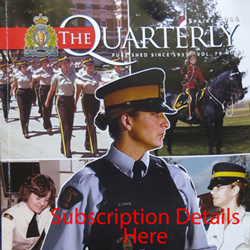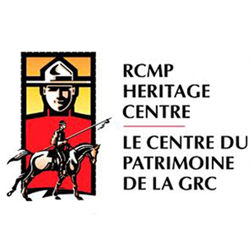Major General Victor Williams
Major-General Victor Arthur Seymour Williams CMG (NWMP – O.82) was a Canadian General Officer in WWI and later became the Commissioner of the Ontario Provincial Police.
Victor Williams was born at Port Hope on June 2, 1867 and was the son of Lieut. Colonel Arthur Trefusis Heneag Williams (previous Canadian Member of Parliament). His father had commanded the 46th Battalion (Middleton Regiment) during the 1885 North West Rebellion and died of typhoid a few days after leading the charge against the rebels at Batoche.
After attending Trinity College School in Port Hope Ontario, Victor Williams entered the Royal Military College in 1884. Two years into his studies, he was withdrawn from the college at his mother’s request. In so doing, he applied to and was accepted into the North West Mounted Police on October 20, 1886 and was issued the regimental number of O.82. In December 1916, he was gazetted as an Inspector in the Force.
In 1886, “Williams was one of four new Inspectors who had attended the Royal Military College in Kingston. The other three officers were: S.T. Wood, P.C.H. Primrose, and T.W. Chalmers.
These new officers were selected through the system of political patronage and geographical representation which was the established practice for filling government positions at the time.”[1]

Image of Inspector Victor Williams’ engagement document into the North West Mounted Police (Source of image – LIbrary Archives of Canada)
Victor Williams served in the Force until September 28, 1889 when he resigned his commission at Calgary and transferred to the Canadian permanent active militia.
He married Helen Euphemia Sutherland on October 23, 1890. In 1893, Victor Williams took a commission with the Royal Canadian Dragoons. With Canada sending a contingent to the Boer War in 1899, he served as a major and later lieutenant-colonel in command of ‘B’ Squadron of the 1st Canadian Mounted Rifles.

Photograph of Major Victor Williams – Commanding “B” Squadron of the Canadian Mounted Rifles in South Africa (Source of photo – Library Archives of Canada)
After returning from the Boer War, Victor Williams was promoted brevet colonel for his overseas service and appointed commandant of the Royal School of Cavalry in Toronto. Then in 1907, he was appointed commanding officer of the Royal Canadian Dragoons and Inspector of Cavalry for the Dominion of Canada.
In 1911, Victor Williams commanded the mounted units at the Coronation of King George V. From 1912 to 1914 he was Canadian Militia’s Adjutant-General at Ottawa.
At the outbreak of World War I, Colonel Victor Williams commanded the Valcartier Camp in Quebec. It was at Valcartier Camp where the 1st Canadian Division trained prior to being shipping off to Europe. The task of organizing this newly formed Canadian Division fell to Victor Williams and a small group of officers. When the 1st Division left for Europe, Victor Williams accompanied them.
During the early states of the war, he served on the general staffs of Field Marshal Sir John French and the British II and III Corps. Victor Williams was eventually promoted to Brigadier-General and placed in command of the 8th Canadian Infantry Brigade of the 3rd Canadian Division from December 1915 to June 1916. This Brigade consisted of: 1st, 2nd, 4th & 5th Battalions of the Canadian Mounted Rifles. His actions on April 30, 1916 were mentioned in dispatches for ‘for gallantry and distinguished service in the field.’
On June 2, 1916, Major General M.S. Mercer and Brigadier General Victor Williams were inspecting the front lines and walked out to see the 4th Canadian Mounted Rifles position on Mount Sorrel and Tor Top. General Byng had been invited to join them but declined the offer.
Mercer and Williams had arrived at the position of the 4th Canadian Mounted Rifles when minutes later the German massive artillery barrage began. The barrage was concentrated on the Canadian positions and continued for 4.5 hours. The Canadian trenches and their defenders had vanished. After the barrage, four German regiments advanced with the support of five regiments and six regiments in reserve. This military engagement would be known as the Battle of Mont Sorrel.
Casualties and death amongst the Canadian troops was extremely high. Major General Mercer had been killed by an artillery shell. Brigadier General Williams was severely wound and taken prisoner by the advancing Germans. He would become the highest ranking Canadian officer to be captured in the war. Victor Williams remained a prisoner-of-war until the Armistice on November 11, 1918.
In 1918, he returned to Canada and was promoted major-general in command of Military District 2 based in Toronto. Victor Williams then commanded military districts in Kingston and Toronto.
In recognition for his dedicated service, a mountain in the Canadian Rockies was named in his honour in 1918 – Mount Williams.
In January 1920 for his dedicated military service, His Majesty King George V appointed Victor Williams a Companion of the Most Distinguished Order of St. Michael and St. George.
On May 1, 1922, Victor Williams was appointed to the position of Commissioner of the Ontario Provincial Police and remained in this position until 1939.
He died in Sunnybrook Hospital, Toronto on December 12, 1949 and was buried in the St. John’s Cemetery in Port Hope Ontario.

Photograph of the grave marker for Major General Victor Williams (Source of photo – RCMP Gravesite database).
If you have photographs and stories which you would like to share and possibly be included in a forthcoming tribute article on this webpage, please email Ric Hall at rshall69@shaw.ca
[1] Beahen, William & Horrall, Stan – “Red Coats On The Prairies: The North-West Mounted Police 1886 – 1990” – Centax Books: PrintWest Publishing Services, Regina, Saskatchewan (1998) – page 154


 November 26, 2013
November 26, 2013 











